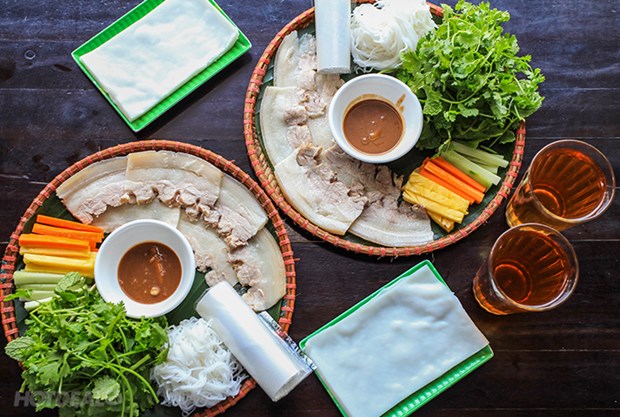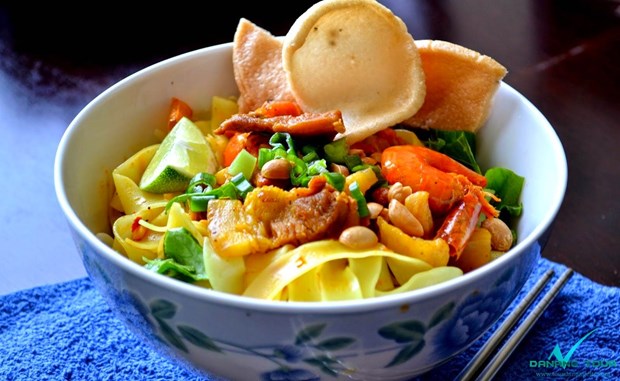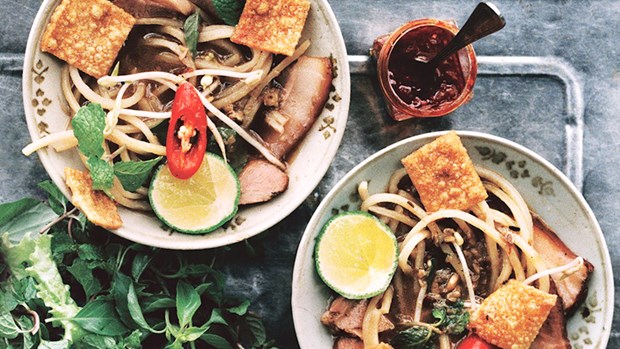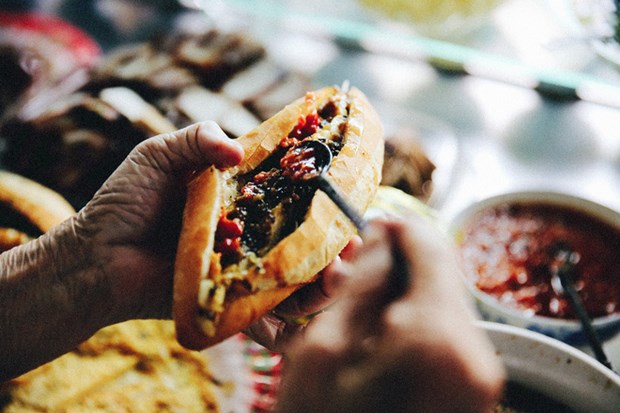7:15am,
our airplane landed at Danang city. The most worth-living city in Vietnam
greeted us by a pleasant day, sunny yet gentle windy.
Indeed,
I’m quite familiar with Da Nang since I’ve travelled to this coastal city 10
times already. However, this trip had brought a very different feeling because
just about half more month, leaders of APEC would come here and who knew which
of those impressive dishes would be served.
Why
not raise our dreams since even former president Obama had created a phenomenon
when he sat on a plastic stool to have traditional famous food of Hanoi called
bún-chả (fresh rice noodles served with grilled pork).
With
that fantastic daydream which is full of colors and flavors, I started my trip
to explore Da Nang – Hoi An’s cuisine, one of the pride of local people to
honored APEC visitors.
While
Hanoians prefer dishes served with/in plain broth and appreciate the delicacy,
Saigoneses love diversity and colors; central food (Hue, Da Nang, Hoi An) is
quite rich and typical with its servings (mixture or rolls) and its spiciness.
Before
getting off the airplane, I was still confused, asking myself what I would
write about the central food of Vietnam when good dishes here as many as in
season. It might take a whole week to try all of them (or most of them). After
filling up my mind with fresh coastal breath, I was much more confident to
begin my trip of exploring the most familiar, rural, and daily food in central
Vietnam.
Hue beef noodles
(bún-bò Huế)
Hue
has dozens of famous specialties, such as Nam Pho rice noodles (bánh-canh), Hue
styled shrimp dumplings served with sweet fish sauce, rice/porridge tiny clams,
and handful types of sweet desserts (chè). However, the most typical choice is
always bún-bò Huế. As Hanoians have to have a hot bowl of phở, we all have to
schedule a bún-bò day.
After
a long trip, we all got tired and a super-hot and spicy bowl of bún-bò could
really wake our senses up. Indeed, we were already awake when seeing the bowls.
Shrimp paste was releasing its special aroma while crab balls and slices of
beef shank were so tempted that I have to taste immediately. Holy Moly! It was
like a wake-up sip ever.

Source: bolsabytes.com
Well,
I am not that hungry to be easy in food tasting. Actually, bún-bò in Hue is a
fine piece of art. The broth is flavorful and robust with lemongrass and shrimp
paste while the whole bowl is a absolutely harmonic painting, white of fresh
rice noodles, green from scallions, and shrimpy pink from spices. It looks good
and eats well also.
Even
the famous picky Anthony Bourdain, who used to take former President Obama to
bún-chả in Ha Noi, had to comment, “What’s a shame if you visit Dong Ba market
in Hue without having a bowl of bún-bò Huế. It’s such a fine dish with pork and
beef bone. This is the most delicious type of soup in the whole wide world that
I’ve tried.”
Another
good thing in Hue is that you can stop by any bún-bò Huế vendor, even on the
street to have a full bowl at 20,000 vnd. Do not hesitate. There are some
dishes too good to be evaluated; you just have them and love them, and bún-bò
Huế is one of them.
Pork rolls
It’s
impossible to tell about pork rolls’ history. People just know that it’s too
typical to miss if you once visited Da Nang city.
The
ingredients are absolutely familiar, including boiled pork, rice paper,
fermented fish sauce and of course, lots of fresh vegetables. However, a right
and fine dish requires secret tips. That’s why they are served everywhere in
Vietnam but I believe (and others, too) pork rolls in Da Nang are not
replaceable.

Source: Hotdeal
Instead
of pork belly, people in Da Nang have used pork butt for the dish, which is
called “double-skin pork”. Ms. Hong, who is in charged of a dining facility
named Mau said that the “double-skin pork” was made from pork butt, where was
next to the tail. The other ingredients are also carefully chosen, such as herbs
from Hoi An or lettuce from Dalat.
Just
look at the dish served together with a small bowl of dipping sauce and a
salver of fresh vegetables, including lettuce, spring onion, basil, green
banana, and sour star fruits can make anyone mouthwatering, especially the
fermented fish sauce from Tra Que.
It’s
an art to enjoy the pork rolls in a right way. We need to take a sheet of rice
paper and place it on a slice of sandwich (without this step, your rice paper
will be more vulnerable), put vegetables by order and a slice of pork on the
wrapper then roll them up and enjoy. The umami taste of good pork combines with
the freshness of lettuce, the spiciness of basil, the acrid taste of green
banana, and the typical hot and spicy fish sauce to create a harmony,
impressive, and charming dish.
Quảng noodles
Once
in a discussion about food, a person from Quang area told me, “Hanoians love phở
but not everyone can cook phở. However, Quang Nam people all can cook Quảng
noodles.” They just wanted to emphasize the important position and popularity
of Quảng noodles in their region and in all over Danang city.

Source: ĐNO
Quảng
noodles can go with different types of meat, including chicken, fish, beef,
pork ribs, shrimps, frogs, and even a mixture of all kinds. Once I had Quảng
noodles in a 30 years old local restaurant, the owner told me that the original
Quảng noodles was with chiken and then fish. The others were added up long time
after just to give tourists and visitors more options.
In
fact, types of meat do not affect the nature of Quảng noodles. It’s so simple
and plain, just like the characteristics of central people in Vietnam. The bowl
has only some ricy noodles, a couple slices of meat, a very small amount of
broth, and some chopped green onion/cilantro for garnishing. However, the size
of vegetables dish is almost triples the amount of noodles.
The
right way to have Quang noodles is to break rice cracker into small pieces, to
add some crushed fresh chili to taste with a lot vegetable then mix them well
and let the noodles absorb as much broth as they can. Some people also love to
bite a bird chili while chewing noodles to feel the stunning yet aromatic hot
on the tongue.
A
good rustic dish can look regular but the longer we eat, the better it tastes.
Quang noodles are an obviously example. Scented rice noodles, umami broth, sour
lime, mildly acrid young mustard, and fresh bean sprouts just well blend and
create an irresistible dish. Once we taste the real Quảng noodles in Quang
region, we can understand why they are so proud of their hometown food.
Hoi An chicken rice
I’ve
always visited Hoi An every single time I stay in Danang, from couple hours to
couple days, just to have a dish of Hoi An chicken rice. It’s like a routine
with me when coming to Hoi An to have chicken rice because it’s too good to be
missed. One of my close friends was quite surprised, saying, “They’re just rice
and chicken. What is so charmed about?”

Source: ĐNO
Well,
we cannot say that! First, chicken rice in Hoi An is definitely different from
common chicken rice. Most of the places prefer soft with a bit elastic rice but
Hoi An just love the tender and bare grains. They soak rice grains in turmeric
water and cook them in chicken broth. The chicken must be from local hens,
crunchy skins and firm flesh that would be mixed with salt pepper, sliced
onions, and herbs.
Real
Hoi An chicken rice would never bring the satisfaction but only create more
needs that just a glance at the dish is enough for mouthwatering. We can season
the rice by fresh chili sauce made in Hoi An if anyone prefer a robust taste.
Looking
attractive, its taste is not any less interesting. No matter how picky you are,
you will be persuaded by the buttery and tender of chicken flesh on the dish of
rice. Onion and răm leaves are not very inherent but they both enhance each
other and fill up all your senses with boldly memorable flavors.
Cao lầu
If
chicken rice, Quảng noodles, or pork rolls are brought all over Viet Nam, cao-lầu
is absolutely local because only made-in-Hoian spices and ingredients can build
a right dish.
Ms.
Thanh, the owner of famous Thanh Thanh cao-lầu restaurant in Hoi An, said that
cao-lầu required pure local water without any chemical residues. They used to
make cao-lầu from water from Ba Le well but in fact, Hoi An has more fine water
sources. The most important step is the pure natural lye water (at least 3
months old from Cham island). This lye water would bring the typical
yellowish/brownish color and incredibly mild taste of cao-lầu noodles.

Source: DNSG
Although
the noodles are quite meticulous, other ingredients are so simple. The finished
bowl just contains blanched noodles, a couple slices of char-siu pork, a couple
pieces of fried pork skin or fried noodles, and handful of herbal leaves from
Tra Que village. Before serving, they usually pour a spoon of char-siu sauce
then serve cao-lầu with a piece of lime and local pungent chili. Remember to
mix them well to enjoy all the typical flavors.
The
cao-lầu noodles are thick, tender, chewy, and slightly crunchy, which can
satisfy any gourmets, especially if they are combined with Tra Que herbs. Fine
food does not mean lots of meat or expensive ingredients and cao-lầu is a great
evidence of it. With simple ingredients, it still can create a worth-trying for
all visitors, both domestic and international.
Hoi An bread
Hoi
An bread has conquered numerous local and international gourmets, even famous
chefs of the world have named it “the best bread in the world”.
Why
we have to have bread in Hoi An? Bread does not originally come from our
country, and of course not from Hoi An either. Moreover, where we can’t find
bread in all over Viet Nam?
Well,
you have your points. But when everyone come to Hoi An and have its bread,
including famous chefs, then why don’t you give it a try? At least we should
know how this street food has stolen everybody’s heart.

Source: eMagazine
In
fact, the unique charm of Hoi An bread is from its different texture between
crispy crust and soft crumb. In addition, the meat is so abundant and various,
such as pork paste, ham, pate, char-siu pork, shred chicken, bacon, cheese,
eggs, and tons of sauces. All you can choose and they are generously stuffed
into the small bread shell until it’s inflated. Finally, fresh herbs from Tra
Que village will be garnished to make the perfectly delicious bread for anyone.
Each
bite goes into raptures when you have a mouthful of flavors. It has to be a
reason why banh-mi seized its place in Oxford dictionary; probably Hoi An bread
has its contribution in that process.
The
above dishes might be too normal to some people but I believe the rustic common
food is the most honest inflection of each region. When we look at the way
they’re served, when we look for their recipes, and when we taste them, it’s
not only to enjoy their flavors but also to understand the whole regional
cultures. I believe they can make a deep impression to APEC attendances if
they’re given a chance to shine.
By Golden Spoon
Awards